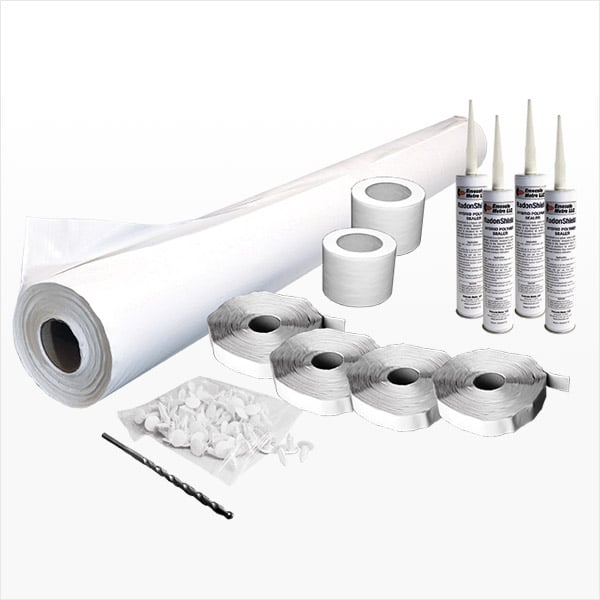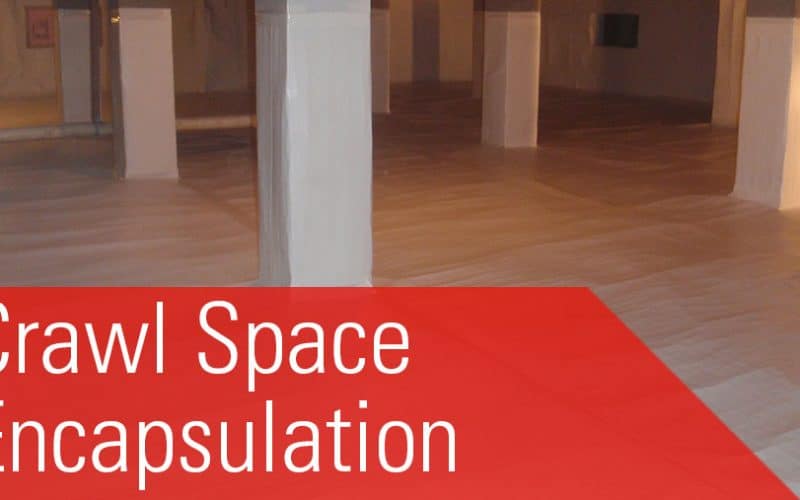While the crawl space plays an important role in many homes in the U.S, people tend to forget it to their disadvantage. Here you’ll find out what crawl space encapsulation is, what materials are used for it, the negatives to encapsulating crawl space, and DIY crawl space encapsulation. These spaces play many important roles in the house, housing the HVAC, electrical, plumbing, gas lines, and irrigation system of your home. So now let’s dive in and find out what crawl space encapsulation means:
What is Crawl Space Encapsulation?
Encapsulation refers to the process of sealing crawl spaces to reduce humidity and prevent leaks, as well as unpleasant effects such as mold and pest invasions. It involves sealing vents, conditioning, and lining the floor and the foundation walls with overlapping sheets of thick polyethylene plastic. Some people also install vapor barriers on exposed floors and wall surfaces. (motivationandlove)
Crawl space encapsulation is also a sealing technique that involves lining the foundation walls and the floor with overlapping sheets of thick polyethylene plastic. This creates an airtight vapor barrier that locks moisture out of your subfloor area. You can also install a dehumidifier to control moisture levels. Crawl space encapsulation is most effective when you seal the space completely. As soon as you’ve encapsulated the space, you can use a dehumidifier to help regulate the moisture levels in the area. The whole process will take a few days’ works but then it is worth every penny and every time.
What are the Benefits of Encapsulating Your Home?
If you don’t always walk into your crawl space, the best thing you can do is to encapsulate your home. Encapsulation will keep it clean and dry. But that’s not all. Here are the benefits of encapsulation.
Lower utility costs
Since encapsulated crawl spaces have insulation and conditioning, they’re more energy-efficient than they were before. Energy savings are in the range of 15-20% when rim joists are insulated and closed-cell foam used. You will find yourself running the HVAC far less than your neighbor who does not have an encapsulated crawl space.
Mold-free home
Like pests, mold thrives in damp floors and walls, which results from an exposed and non-conditioned crawl space. Mold is a health hazard. Exposure to mold spores can trigger allergies and other respiratory problems such as asthma. Encapsulation ensures your crawl space remains dry, denying mold the opportunity to grow and colonize your living space.
Enhanced home comfort
Another benefit of encapsulating the crawl space is that it increases the comfort levels in your home. A vented crawl space makes the home hotter in summer and colder in winter. Both can make the indoors unbearable. Any changes in the external conditions will result in a change in the internal conditions too. Remember also that 50% of the indoor air you breathe comes directly from the crawl space/basement. By encapsulating this space, you prevent reoccurring pests and other toxic gases from getting into your home.
Fewer pest incursions
A wet and dark crawl space almost always attracts pests and crawling insects. When you let them come in, they multiply quickly and take over your home. They can damage wood joists and other belongings. But even more worrying is that they can be difficult and costly to eradicate. A polyethylene barrier will keep out moisture and make the area less desirable to pests.
Improved structural integrity
Wet soil following a downpour can weaken the foundation. That’s why water is always channeled from the foundation walls. But that’s not the only thing that can undermine your structural integrity. A vented crawl space will too. Coupled with interior drainage and a sump pump system, crawl space encapsulation keeps the soil around the perimeter of the foundation dry, preventing cracks and soil shift, which can cause serious and costly structural problems.
An encapsulated crawl space offers many lasting benefits, including a clean, healthier, and comfortable home. If you feel your crawl space needs urgent encapsulation, look for a local contractor for your crawl space encapsulation.
DIY Crawl Space Encapsulation
DIY crawl space encapsulation is essentially sealing your dirt floor in the crawl space using a vapor barrier, insulating the crawl space walls, and installing a dehumidifier. It also involves sealing off all vents and outdoor openings to prevent the entry of humid air from outside. DIY crawl space encapsulation is a step-by-step guide to encapsulating your home.
#1. Examine your home: the first thing you have to do is inspect the crawl space and your home’s layout. Next, ensure that your home has is graded correctly. To effectively remove all mold and fungus, you can fog your crawl space. Lastly, spray a mold prevention solution on the wood to prevent molds from ever growing again.
#2. Repair and replace your crawl space: this entails repairing and replacing the old structure you have in your crawl space with new ones.
#3. Seal the vents, outdoor spaces and install the vapor barrier.
#4. You will have to remove the current moisture barrier and install a new one.
#5. Dry your crawl space and keep it clean.
#6. Try to do regular inspections on your crawl space.
What are the Negatives to Encapsulating Crawl Space?
Despite all the benefits of crawl space encapsulation, it doesn’t come without its negatives to encapsulating crawl space, and unfortunately, most of these negatives will hit your pocket.
#1. Encapsulation is Expensive
The most important negatives to encapsulating crawl space that deserves to be pointed out are the unarguable reason that shows encapsulation is not a cheap process. Not every home needs encapsulation, but many homeowners still see enough importance in it to decide to go through with it. Most homeowners save money by installing a 6-millimeter plastic vapor barrier to protect their home’s wood structure from moisture. But I won’t advise you to do the same if you want a lasting DIY crawl space encapsulation.
Although many homes need to encapsulate their crawl space, many homes don’t, and this process will only hurt their pockets. This is in no doubt the most notable disadvantage of this process.
#2. Encapsulation May Require Additional Insulation
Another negative to encapsulating crawl space is the fact that you may have to have foundation wall insulation. Some contractors will recommend additional rigid foam insulation on the inside of the foundation walls.
Other than the cost, rigid spray foam insulation can hide termite activity. Many contractors cover the masonry walls as well as the wood beams. It’s recommended if spray foam is being added to discuss the risk of termites and if leaving the wood exposed is preferred.
#3. Encapsulation May Require HVAC Upgrade
Encapsulation can also lead to more expenses in the form of upgrading your HVAC system. Encapsulated crawl spaces will limit the amount of free-flowing air in your house. Your current HVAC system may require more airflow to function properly. So you might need to upgrade your HVAC to keep your house’s temperature at a stable and consistent level.
#4. Encapsulation Will Require More Maintenance
After encapsulating the crawl space, you will likely need to do additional maintenance. This depends on the number and kind of features you installed during the encapsulation. Additional maintenance can include maintaining gutters, sump pumps, etc. Maintenance costs can add up to more than what you would have been paying without the crawl space encapsulation.
You may not see a return on investment on encapsulation for those who live in an area that doesn’t see a lot of rainfall (such as in the southwest). The main benefit of sealing out moisture won’t be realized because you have low rainfall levels and your crawl space is already dry and moisture-free.
#5. Dehumidifiers Require Routine Maintenance
Lastly, the dehumidifier will need regular service to run correctly. The dehumidifier should be serviced at least once a year. Dehumidifiers have filters that need to be cleaned or replaced. Also, dehumidifiers in crawl spaces use a condensate pump to push moisture to the crawl space’s exterior. Condensate pumps can become blocked, which will require service to clear.
However, all of these disadvantages need to be taken with a grain of salt. There are many advantages that, in our opinion, overshadow the disadvantages – we once again advise that you consult an expert and have them take a look at your crawl space before you make any big decisions.
Crawl Space Encapsulation Material

For your crawl space encapsulation material, you’ll need vapor and thermal barriers, a dehumidifier, a drainage system, insulation, lighting, and more. Insulation alone can run as high as $300, depending on the size of your space. Dehumidification can help bring down moisture to 50%, which is where it should be.
Sourcing the right crawl space encapsulation materials are almost as important as having your crawl space encapsulated. Though there are different brands to shop from, almost all barriers are made from 100% polyethylene resin with reinforced polyester cord. Rolls are also available in various sizes ranging from 675ft to 1200ft.
For the floor, we recommend the 20 mil plastic crawl space vapor barrier, as it’s strong and thick enough to allow for heavy to medium storage. You can use it to cover stone or concrete floors or any crawl space with high traffic.
Sorting your Materials
You can get the 20mil plastic vapor barrier of any roll size from your local hardware store. Prices can range from a couple of hundred dollars to more than a thousand dollars for the large and thicker roll size. Since encapsulation is a long-term investment, we recommend the durable 20-mil roll over the thinner 6-mil. You don’t want to be replacing your plastic barrier every two or three years, would you?
Some online shops also sell them. While it may be cheaper to order your materials online, we recommend that you ask your local crawl space encapsulation contractor to help you source the right materials. After all, it’s what they do as professionals, so they should be able to know what works best for your crawl space.
That being said, no crawl space work is DIY, and it’s best to leave the finer details to a local crawl space repair contractor. That way, the heavy-duty encapsulation also will be protected with a longtime warranty.
How Does Crawl Encapsulation Works?
- When enclosing a property, crawl space contractors follow a similar process.
- A thorough examination of the vented crawl space’s condition.
- Removing old insulation, addressing moisture problems, removing bugs, and repairing cracks
- Foam insulation is sprayed around external pipes and ducts to seal holes, vents, and gaps.
- The use of a heavy-duty plastic vapor barrier on the floor and walls is recommended.
- Using tape or fasteners to secure portions and keep them together so there are no gaps
- Install a dehumidifier to keep moisture levels in the crawl area at an acceptable and constant level (below 50%) throughout the year.
- The contractor will caulk and tape the insulating material around piers and pillars when installing it.
IN CONCLUSION
The benefits of this are long-lasting. You won’t have to worry about moisture attacking your crawl space, and pests will have less interest and opportunities to gain a foothold. Also, your home will be much warmer and you’ll spend less energy regulating the internal conditions.
FAQs
Does a crawl space need a vapor barrier?
Yes. In your crawl area, you’ll need a vapor barrier. Furthermore, a moisture barrier is the bare minimum of protection that your crawl space should have. A vapor barrier can help you prevent costly repairs.
Can I encapsulate my crawl space yourself?
A wet crawl space also decreases the effectiveness of your HVAC system, but all of this may be solved with a simple encapsulation. Crawl space encapsulation is tough to complete without the help of professionals, but anyone with the correct tools and supplies can do it.
Does an encapsulated crawl space need a dehumidifier?
For flooding or standing water, a crawl space dehumidifier is not the answer. It could, however, be valuable as part of a moisture and dampness control system. A dehumidifier is rarely required if an encapsulation and drainage system are properly fitted.






